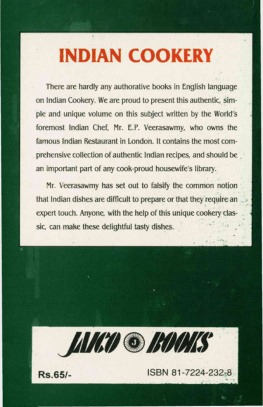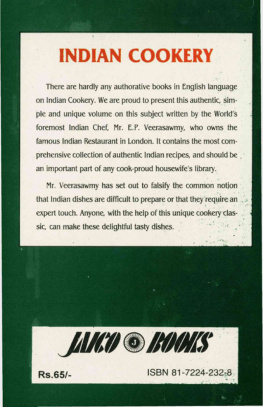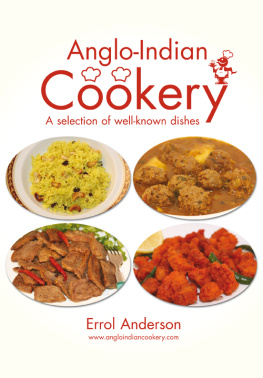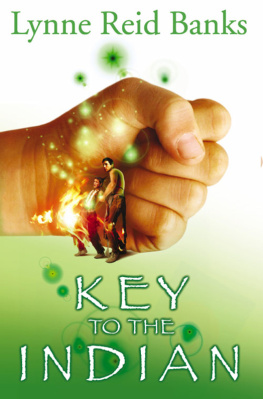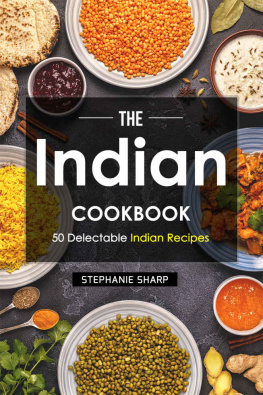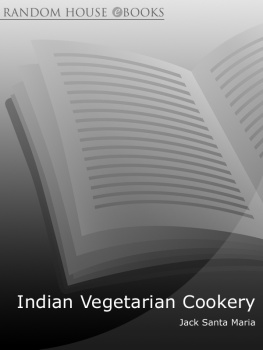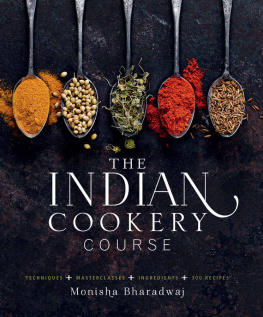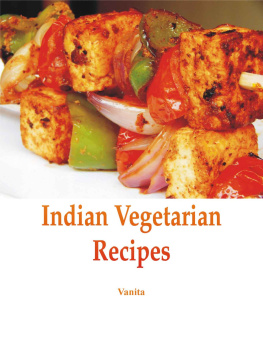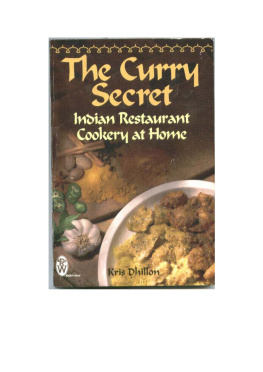Veeraswamy - Indian Cookery
Here you can read online Veeraswamy - Indian Cookery full text of the book (entire story) in english for free. Download pdf and epub, get meaning, cover and reviews about this ebook. year: 2014, publisher: Jaico Publishing House, genre: Home and family. Description of the work, (preface) as well as reviews are available. Best literature library LitArk.com created for fans of good reading and offers a wide selection of genres:
Romance novel
Science fiction
Adventure
Detective
Science
History
Home and family
Prose
Art
Politics
Computer
Non-fiction
Religion
Business
Children
Humor
Choose a favorite category and find really read worthwhile books. Enjoy immersion in the world of imagination, feel the emotions of the characters or learn something new for yourself, make an fascinating discovery.
- Book:Indian Cookery
- Author:
- Publisher:Jaico Publishing House
- Genre:
- Year:2014
- Rating:3 / 5
- Favourites:Add to favourites
- Your mark:
- 60
- 1
- 2
- 3
- 4
- 5
Indian Cookery: summary, description and annotation
We offer to read an annotation, description, summary or preface (depends on what the author of the book "Indian Cookery" wrote himself). If you haven't found the necessary information about the book — write in the comments, we will try to find it.
There are hardly any authorative books in English language on Indian Cookery. We are proud to present this authenric, simple and unique volume on this subject written by the Worlds foremost Indian Chef, Mr. E.P. Veerasqwmy, who owns the famous Indian Restaurant in London. It contains the most comprehensive collection of authenric Indian recipes, and should be and important part of any cookprouud housewifes library.
Indian Cookery — read online for free the complete book (whole text) full work
Below is the text of the book, divided by pages. System saving the place of the last page read, allows you to conveniently read the book "Indian Cookery" online for free, without having to search again every time where you left off. Put a bookmark, and you can go to the page where you finished reading at any time.
Font size:
Interval:
Bookmark:

INDIAN COOKERY
Mrs. Surjeet Malhan

Hyderabad Chennai Ahmedabad
Jaico Publishing House
No part of this book may be produced or utilized inany form or by any means, electronic or mechanicalincluding photocopying, recording or by anyinformation storage and retrieval system, withoutpermission in writing from the publishers.
INDIAN COOKERY
ISBN 81-7224-271-9
Eleventh Jaico Impression: 2002
Published by
Jaico Publishing House
121, Mahatma Gandhi Road,
Mumbai - 400 001
Printed by
R. N. Kothari
Sanman & Co.
113, Shivshakti Ind. Estate,
Marol Naka, Andheri (E),
Mumbai - 400 059.
INDIAN COOKING
INTRODUCTION
What is a typical Indian meal? It is a difficult question to answer as the variations in food and food habits are as numerous as are the differences in the physical, social, economic and cultural aspects of the country. The climatic extremes vary from sub-temperate and temperate in the mountain regions to tropical in desert and plains. Added to all these variations are the quasi-religious taboos. Thus, eating habits not. only differ in the context of variations just mentioned, but are also determined by set attitudes sanctified by religious and semi-religious injunctions.
Some Indians are such strict vegetarians that they will not even take certain types of vegetables such as onions, root vegetables, tomatoes and brinjals (egg plant). Their main source of protein is milk, milk products, pulses, lentils and nuts. There are others who do not eat egg or chicken but take fish and mutton Muslims are forbidden to eat pork, ham or bacon, and Hindus deem it sinful to take beef. Among some communities, milk and milk products are not served in the same meal with meat or fish. Again, we find people in this country who do not take leafy vegetables during the monsoon season.
The influence of neighbouring countries is also well marked, especially on North Indian cuisines. Mughlai foods (associated with the splendour of the Moghal emperors who kept a truly royal table of numerous delicacies) have a similarity with the meat preparations of the Middle Eastern countries. Dishes such as Biryani and Kababs, Tandoori foods, unleavened breads and the idea of roasting or grilling meat on skewers are derived from Indias West Asian neighbours.
People in North India serve wheat as the staple dish. This is made into chapatties or phulkas, resembling in appearance the Mexican torlilla. Another rendering is the parathaa shallow fried preparation like the chapatti, which is sometimes stuffed with vegetables or minced meat. Stuffings for parathas may be cooked or uncooked depending upon the recipe. Naan and Tandoori roti, baked in clay-oven, are other kinds of breads traditionally served. Bread is served with curries, which are prepared with meat, onions, poppy seeds, coconut, and other condiments.
Rice is not the staple food of North Indians but Pulao (akin to the Greek word Pilaff) or Biryani is served on special occasions. Pulao or Biryani is served with mutton, chicken or vegetable curries or with raita, which is a yoghurt preparation. Raita is prepared by adding ground spices and chopped or sliced vegetables like cucumber, boiled potatoes, tomatoes, onions, and mint leaves to well-beaten yoghurt. Rice dishes are garnished with browned fried onions, nuts, boiled eggs, sultanas, and silver and gold foils. Often rice dishes are made colourful by the addition of edible colours. Saffron is used to add special flavour. Khichri, another rice dish prepared with lentils and spices, is also popular. Moong dal, with skin removed, is used for its preparation.
Seekh Kababs made of minced meat are prepared with skewers on open coal fire. Meat for kababs is free from fat and bones and it is very finely ground.
For Barra Kababs, meat is used mostly from arms or calf muscles, cut into cubes, soaked in spices and yoghurt and ground pappya (that is if pappya is available) for few hours and then the pieces are threaded on skewer and roasted in a very hot clay-oven while fat is poured on them. Shami Kababs are also very popular. These are made from a mixture of minced meat and grams. Another very popular North Indian dish is Tandoori Chicken. Chicken is soaked in yoghurt, pappya juice and ground spices. If pappya is not available, little vinegar is added. Chicken is allowed to soak for six to eight hours before it is cooked. Then it is threaded on an iron skewer and roasted in clay oven commonly known as tandoor. It can also be cooked in a very hot electric oven. Tandoori chicken is served with sliced onions and lemon. Chicken is also prepared in curry form with yoghurt, coconut and spices. Chicken Kababs are delicious to eat with parathas, naans or tandoori chapatties.
Special care in selection of meat is essential. Meat for all mutton dishes should be pinkish red in colour, fine grained and velvety to the touch. Fat should be firm and brittle; and bones white and spongy. Natural flavour of the animal meat should be ensured. For all dishes fresh meat is used. Goat is preferred to lamb for mutton dishes.
Vegetable curries are also very popular and these are served with bread or rice. These are prepared in dry or curried form with onions, spices and ghee or butter. There are different kinds of fresh vegetables available in different seasons. Frozen or canned vegetables are not very popular. Fresh vegetable curries commonly take place of meat curries. Spices used are practically the same as for meat or chicken curry. A very popular dish in the north is Mutter Panir, which is made from cottage cheese, cut into cubes, fried and then cooked with fresh peas. The method of preparation is somewhat the same as for meat and chicken curries.
Lentil or dal is another favourite dish of North Indians. This is prepared in dry or semi-liquid form, lightly or highly spiced, depending upon individual taste.
Varieties of Pickles and Chutneys are served with meals. Most popular ones are mint chutney, mango chutney, mango pickles, lemon pickles and tomato chutney. Sweet or sour pickles are made from turnips, cauliflower and carrots. In preparing of these pickles, large quantities of mustard oil, mustard seeds, aniseeds, onion seeds, red chillies and salt is used. Mostly uncooked vegetables are used for pickling. When cooked, the> are lightly boiled. Mustard seeds and spices ferment and render some taste to pickles. Vinegar is seldom used for making pickles. Only for cauliflower, turnip and carrot pickles, a little vinegar is used along with other spices.
Papad, called papadum in the West, is another food accessory. It is prepared from lentil flour, urad dal or moong dal or boiled potatoes mixed with lentil flour. Plenty of whole black pepper, ground red chillies and cumin seeds are used. Lentil flour with spices is made into very tough dough and then rolled into thin circular sheets. It is well dried in the sun for about 3 to 4 days. At the serving time, it is deep fried in fat. When it floats up and becomes crisp, it is done. In boiling fat, it takes only a few seconds to fry a papad. Sometimes it is roasted on open coal fire or electric oven.
Desserts or sweets dishes are mainly made of milk. Kheer is a popular dessert. Rice or rice flour, puffed rice, sago or cream of wheat is cooked in large quantities of milk for a long time until milk attains a thick butter-like consistency. It is then sweetened and flavoured with blenched sliced almonds, pistachios, saffron and cardamom. It is usually decorated with edible gold or silver foils. Suji ka Halwa is another popular dish. It is prepared with equal quantities of cream of wheat, sugar and ghee (clarified butter). About four times the quantities of water is added. This dish has a thick consistency when done and is garnished in the same way as Kheer. Carrot Halwa is also a favourable dish of North Indians. This is prepared from one part of grated carrots with four parts of milk cooked into a very thick consistency, then sweetened and garnished as Kheer.
Font size:
Interval:
Bookmark:
Similar books «Indian Cookery»
Look at similar books to Indian Cookery. We have selected literature similar in name and meaning in the hope of providing readers with more options to find new, interesting, not yet read works.
Discussion, reviews of the book Indian Cookery and just readers' own opinions. Leave your comments, write what you think about the work, its meaning or the main characters. Specify what exactly you liked and what you didn't like, and why you think so.

